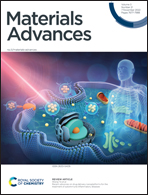The effect of multiple ion substitutions on halide ion migration in perovskite solar cells†
Abstract
Lead halide perovskites are mixed electronic-ionic conductors. Ionic mobility is related to device stability; the more favourable ion migration is, the sooner material degradation occurs. The highest efficiency perovskite materials, such as Cs0.05(FA0.83MA0.17)0.95Pb(I0.83Br0.17)3,include multiple substitutions into the parent FAPbI3 structure. Despite the high efficiencies that multi cation and anion cells can achieve, there is still a poor understanding of the effect of mutiple substitutions on ion mobility within the perovskite itself. In this report we use electrochemical impedance spectroscopy to evaluate the effect of ion substitution at multiple sites on the activation energy for iodide diffusion. The results demonstrate that crystal lattice subsitutions have a significant effect on the activation energy. The addition of smaller cations into the FAPI lattice greatly reduces the barrier to iodide diffusion. When substitutions at multiple lattice sites are made, as in the triple cation perovskite, Cs0.05(FA0.83MA0.17)0.95Pb(I0.83Br0.17)3, the activation energy of iodide diffusion is 0.81 eV. This is considerably higher than the experimental values obtained for methylammonium lead iodide and furthers understanding of the effect of multiple substitutions on perovskite stability.



 Please wait while we load your content...
Please wait while we load your content...